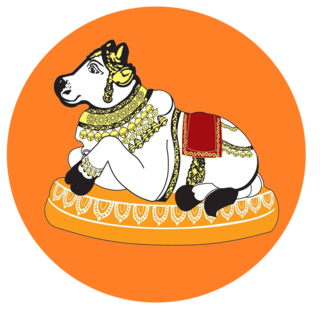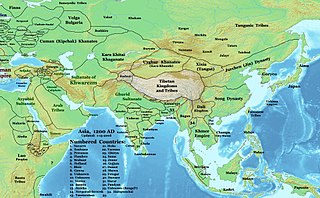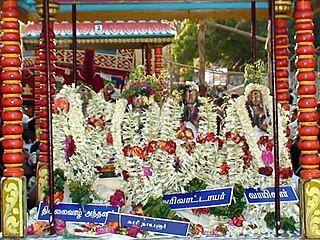Related Research Articles
Hari or Har(i) is a name for the supreme absolute in the Vedas, Guru Granth Sahib and many other sacred texts of South Asia. Hari refers to God who takes away all the sorrows of his devotees. In the Rigveda’s Purusha Suktam, Hari is the first and most important name of God, an alternative name of the supreme Being is Narayana after Hari and Purusha according to Narayana Suktam of theYajurveda. Within the Hindu tradition, it is often used interchangeably with Vishnu to such an extent that they are considered to be one and the same. In the Vedas, it is required to use the mantra "Harih om" before any recitation, just to declare that every ritual we perform is an offering to that supreme Divine Being; even if the hymn praises some one or the other demigods. The idea of demigods as found in Hinduism is very different from that found within Greco-Roman mythology. This has to be borne in mind while understanding how, within Hinduism, all beings including demigods are inseparable from Hari. The phrase "Harih Om" gestures towards Advaita Vedanta and other categories of non-dual thinking. "Harih Om" is akin to saying that all creation that we can see is in fact, a mirroring of the One Self. This is not the concept of mimesis as found in Western philosophy.
Marathi literature is the body of literature of Marathi, an Indo-Aryan language spoken mainly in the Indian state of Maharashtra and written in the Devanagari script.

Vithoba, also known as Vi(t)thal(a) and Panduranga, is a Hindu deity predominantly worshipped in the Indian state of Maharashtra. He is generally considered as a manifestation of the god Vishnu or his avatar, Krishna. Vithoba is often depicted as a dark young boy, standing arms akimbo on a brick, sometimes accompanied by his main consort Rakhumai.

Allama Prabhu was a 12th-century mystic-saint and Vachana poet of the Kannada language, propagating the unitary consciousness of Self and Shiva. Allama Prabhu is one of the celebrated poets and the patron saint of the Lingayata movement that reshaped medieval Karnataka society and popular Kannada literature. He is included among the "Trinity of Lingayathism", along with Basavanna, the founder of the movement, and Akka Mahadevi, the most prominent woman poet.

Hoysala literature is the large body of literature in the Kannada and Sanskrit languages produced by the Hoysala Empire (1025–1343) in what is now southern India. The empire was established by Nripa Kama II, came into political prominence during the rule of King Vishnuvardhana (1108–1152), and declined gradually after its defeat by the Khalji dynasty invaders in 1311.
Marathi poetry is a poetry written in the Marathi language, including its various dialects. Marathi is one of the official languages of India.
Chamarasa was an eminent 15th century Virashaiva poet in the Kannada language, during the reign of Vijayanagar Empire, a powerful empire in Southern India during 14th - 16th centuries. A contemporary and competitor to a noted Brahmin Kannada poet Kumara Vyasa, Chamarasa was patronised by King Deva Raya II. The work is in 25 chapters (gatis) comprising 1111 six-line verses (shatpadi).
Rudrabhatta was an influential 12th-century Kannada poet in the court of the Hoysala Empire King Veera Ballala II(r.1173–1220 CE). According to Kannada language expert Narasimhacharya, the poet was also patronized by a minister of the King. The literary critic Mukherjee feels that after a century of literary revolution caused by the Veerashaiva poets, a benevolent atmosphere created by the king may have encouraged this Vaishnava writer and poet.

Mysore literature in Kannada is a body of literature composed in the Kannada language in the historical Kingdom of Mysore in Southern India and written in the Kannada script. The writings date from the Kingdom of Mysore, which existed from around 1600 CE until the establishment of modern India in 1947. Many of the works of this literature written on religious themes are labeled Veerashaiva or Vaishnava in acknowledgment of the two faiths that gave form to the literature and fostered it until the advent of the modern era. Despite a gradual decline in the popularity of Jainism, authors devoted to the faith produced some works of merit. Secular themes dealing with a wide range of subjects were also written on. Kannada literature flourished for a short while in the court of the neighbouring kingdom of the Nayakas of Keladi whose territory was annexed by Mysore in 1763.
Nijaguna Shivayogi was an Indian poet and a prolific writer in the Kannada language. He lived in the 15th century. He was a follower of the Veerashaiva faith, which he attempted to reconcile with the Advaita Hinduism of Adi Shankaracharya. Tradition has it that Shivayogi was a petty chieftain of Kollegal taluk in modern Mysore district of Karnataka state, India. Considered a visionary of his time, his Vivekachintamani, written in encyclopaedic proportions and in prose style, and the Kaivalya Paddhati, a musical treatise consisting of songs are considered his most enduring works.

Vijayanagara literature in Kannada is the body of literature composed in the Kannada language of South India during the ascendancy of the Vijayanagara Empire which lasted from the 14th through the 16th century. The Vijayanagara empire was established in 1336 by Harihara I and his brother Bukka Raya I. Although it lasted until 1664, its power declined after a major military defeat by the Shahi Sultanates in the battle of Talikota in 1565. The empire is named after its capital city Vijayanagara, whose ruins surround modern Hampi, now a World Heritage Site in Karnataka.

Raghavanka was a noted Kannada writer and a poet in the Hoysala court who flourished in the late 12th to early 13th century. Raghavanka is credited for popularizing the use of the native shatpadi metre in Kannada literature. Harishchandra Kavya, in shatpadi metre, is known to have been written with an interpretation unlike any other on the life of King Harishchandra is well known and is considered one of the important classics of Kannada language. He was a nephew and protégé of the noted Early 12-century Kannada poet Harihara. Although the shatpadi metre tradition existed in Kannada literature prior to Raghavanka, Raghavanka inspired the usage of the flexible metre for generations of poets, both Shaiva and Vaishnava to come.
Visoba Khechara, spelled also as Visoba Khechar or Visoba Khecar, was the yogi-guru of the Varkari poet-saint Namdev (c.1270-1350) of Maharashtra, India. Visoba was a disciple of the Varkari poet-saint Jñāneśvar. He had linkages with the Varkari tradition as well as the Nath tradition of Maharashtra. He preached the omnipresence of God and thus denounced idol-worship. Though a staunch Shaiva, Visoba has composed verses in praise of the god Vithoba, the patron deity of the Varkari faith. He has also composed a metaphysical treatisecalled the Shatsthala.
Religions and Social Activities in Maharashtra are well diverse democracy and all mixed cultures as like the rest of India. Maharashtra has a history of more than 1000 years in Religions, Social Festivals, diverse cultures and much more.

Kari Nayanar is the 47th Nayanar saint. Traditional hagiographies like Periya Puranam and Thiruthondar Thogai detail his legendary life and services to the Hindu god Shiva. Kari Nayanar was a vedic Brahmin devotee as well as a Tamil poet with an understanding of Sanskrit. The poet-saint compiled the vedic truths in Kovai(Anthology), a Tamil composition titled Karikkovai. Therefore the saint got the name as Kari Nayanar.
Shiromani Narahari Sonar or Narhari Sonar is a 13th-century Hindu poet-saint of the Varkari sect and goldsmith from Maharashtra, India. His hagiography speaks about his transition from a staunch Shaiva to a Vithoba-worshipping Varkari after a miracle that makes him realize that Vithoba and Shiva are one and the same.

Sayyid Sheikh Muhammad Qadiri (1560–1650), also known as Baba Sheikh Mohammad of Shrigonde, was a Muslim saint-poet who is venerated by Hindus. He is considered the most well-known Marathi Muslim poet. He is the author of the Yoga-samgrama (Yoga-sangrama).
Shridhar Brahmanand Nazarekar, popularly known as Shridhar Swami Nazarekar or Shridhar Pandit, was a popular Marathi Akhyanaka (narrative) poet and philosopher who wrote several caritra granthas in the 17th and 18th centuries. Shridhara was a puranik, that is one who recite stories from Puranas. Later he began to compose works himself in a simple devotional style, and were not only extremely popular, but were revered and worshipped like sacred texts.
Shivlilamrut is a devotional poem composed by the Marathi poet-saint Shridhar Swami Nazarekar.
Shri Ram Vijaya is a popular devotional literature composed by Shridhar Swami Nazarekar (1658-1729) in Marathi. It literally means 'Victory to Rama, an incarnation of Vishnu'.
References
- ↑ Ayyappappanikkar (1997). Medieval Indian Literature: Surveys and selections. p. 371.
- ↑ Dinakar Dhondo Karve (1963). The New Brahmans: Five Maharashtrian Families . University of California Press. p. 19.
He mentions Harivijay (Victory to God Hari [Shiva]), Ramavijay (Victory to Rama, an incarnation of Vishnu), Shivlilamrit (The Nectar of Shiva's Play), and Laghu-Guru-Charitra (The Story of Guru [the God Dattatreya]). These collections of legends about gods and supernatural figures are typical of traditional Marathi vernacular literature. The first three are by Shridhar (1678- 1728), the most prolific of marathi poets.
| This article related to a book about Hinduism is a stub. You can help Wikipedia by expanding it. |